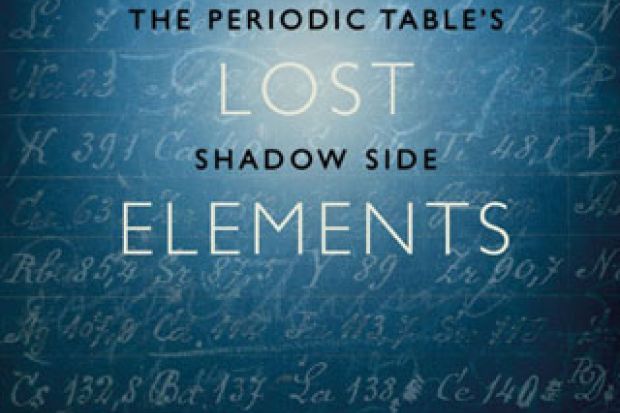As a teenager I would regularly go into second-hand bookshops looking for old chemistry texts (what teenager doesn’t?). One that had a lasting impact on me – and is still in my collection – was titled Text-Book of Elementary Chemistry for the Use of Schools and Junior Students by J. P. Bidlake, published in 1858. What fascinated me about this particular book was that a lot of the chemistry was “wrong”. For instance, the formula for water was simply HO. And in its “Table of Elementary Substances”, in addition to the familiar elements of carbon, chlorine, sulphur and so forth, were included a number in italics (signifying that they were “rare”) with names such as aridium (symbol Ar), didymium (D), donarium (Do), glucinium (G), ilmenium (Il), norium (Nr) and pelopium (Pe). These were nowhere to be found on the periodic table hanging on my bedroom wall. Thankfully, we now have a book that explains the stories behind these, and almost a couple of hundred other, “lost elements”.
This scholarly work is clearly a labour of love, and it is easy to see why The Lost Elements has been 14 years in gestation. While finding out how elements were discovered is relatively straightforward, digging up accounts of claims that turned out, for one reason or another, to be false is much harder. Marco Fontani, Mariagrazia Costa and Mary Virginia Orna have gone to immense efforts to provide a thoroughly comprehensive account of simple errors, wrong turns, rediscoveries, unsubstantiated crazy theories, quackery and even downright deception, from the time of Antoine Lavoisier’s 18th-century conception of what an element is, to modern-day accounts of Cold War rivalries between physicists in their syntheses of the newest and heaviest elements. Few other scholars, one imagines, would be so dedicated as to visit the family of Eugène-Anatole Demarçay (1852-1903), proposer of the elements Σ, Γ, Δ, Ω and Θ, to check his death certificate, or to trek to the volcanic region of Damaraland in Namibia to photograph the miniature “craters of death” that issue a poisonous mixture of hydrogen and hydrogen sulphide once thought to be a new element, damarium.
There are many lessons to be learned from this book, not least that science is far from straightforward and that even the very best minds err from time to time. The great Scottish chemist William Ramsay, discoverer (or co-discoverer) of an entire group in the periodic table – helium, neon, argon, krypton, xenon and radon – is a case in point. I have long been a fan of this highly skilled scientist (and even own a signed copy of one of his works). But I was unaware that, in 1897, he suggested that his most recent discovery – argon – might prove to be a mixture of three new elements, which he patriotically proposed to call anglium, scotium and hibernium. Similarly, the Italian physicist Enrico Fermi, refusing to believe that a tiny neutron could cause a massive atom of uranium to split, thought he had created the first transuranic elements, whose suggested names included ausonium and mussolinium.
I have just two (very slight) criticisms. The first is that occasionally there may be just a bit too much detail for the general reader. While this plethora of information is great for a chemist – I found myself trying to guess what some of the false discoveries might be from the authors’ in-depth descriptions of their reactions (and failing in every case, except once when the answer was “water vapour”!) – it is likely to be too much for a layperson, or a physicist. The second area where I felt just a little dissatisfied is with the organisation of the sub-sections within the book. There is probably no ideal way to group so many different false discoveries, and the proposed divisions seem sensible enough, but at times the authors stray over their own borders, or must revisit earlier accounts without cross-referencing. But these are tiny personal niggles, and utterly insignificant when balanced with the book’s great treasure trove of stories: the Oxford don driven to drink after the rejection of his primary substances coronium, nebulium and archonium; the Russian mineralogist arrested by the secret police for sabotaging Soviet science with his elements from space. My favourite non-element? It would have to be gnomium. Thank goodness these stories have been brought back to life.
Peter Wothers is director of studies in chemistry, St Catharine’s College, Cambridge.
The Lost Elements: The Periodic Table’s Shadow Side
By Marco Fontani, Mariagrazia Costa and Mary Virginia Orna
Oxford University Press, 576pp, £25.99
ISBN 9780199383344 and 83351 (e-book)
Published 20 November 2014




